It is impossible to be skeptical of the growing popularity of Blockchain Technology, which has been applied in almost every industry, including Healthcare, Education, eCommerce, Finance, Manufacturing, etc. The blockchain market is expected to reach 68 billion USD by the end of 2026, thanks to the widespread adoption of blockchain applications across multiple industries. Its growth also results in the emergence of numerous Blockchain Protocols, making it difficult for your company to select the best one. Each blockchain has its own competitive advantages and claims to solve otherworldly problems. For example, if one protocol can handle interoperability, another can handle speed, and yet another can handle scalability. So, which Blockchain Protocol is best suited to your company's size? Keep reading to learn more!
1. Different Types Of Blockchain Protocols
Protocols are critical components of Blockchain technologies that allow information to be shared automatically and securely across cryptocurrency networks. Blockchain Protocols can be divided into 3 main categories, namely public protocols, private protocols, and hybrid protocols:
Public Protocols: They are permissionless, open-source blockchains that anybody may access and benefit from. It means that any developer can join the network by downloading and launching a node. Ethereum is a public protocol that enables users to create and operate smart contracts without having to develop their own ecosystem. Anyone can create a decentralized application (Dapp) on Ethereum if they buy Ether to use as GAS, the fuel that their software programs need to run. Other public blockchain protocols are Bitcoin, Stellar, etc. Its benefits are highly decentralized and thus immutable — once verified, data cannot be altered. It instills trust and transparency in its participants, but at the expense of efficiency and cost due to its lengthy and energy-intensive confirmation process.
Private Protocols: Private blockchain protocols, unlike public ones, require authorization to access and function under the appearance of a centralized organization. Entrance control procedures can range from allowing existing participants to nominate future entrants to require a user to complete a predetermined set of tasks before being granted admission. After joining the network, an entity will assist in the decentralized maintenance of the blockchain. Because the system relies on internal players to validate transactions, there are no game-theoretic incentive structures in place to protect the network. Private blockchains are more efficient in terms of scalability and compliance with legal norms due to centralized control, but they are prone to network manipulation.
Hybrid Protocols: They are, as the name says, a mix of public and private ones. IT professionals can employ both public and private chains while developing a project on a hybrid network. While some information can be held on a private chain, a public chain can establish a consensus on a different set of facts. That is why it is referred to as a hybrid protocol.

Different types of Blockchain Protocols
2. Why Does A Blockchain Protocol Matter?
The choice of protocols is one of the most important criteria to consider when launching a Blockchain Development Project as it will determine the functionality that your Software can offer. Typically, the most advanced protocols include highly sophisticated technologies that required the collaboration of thousands of computer scientists. Using a protocol, rather than reinventing the wheel, allows you to complete your project in less time and with fewer resources.
3. What Factors To Consider To Choose The Most Appropriate Blockchain Protocol?
a. Speed
When selecting a Blockchain Protocol, one of the most important factors to consider is speed. For example, Solana, a new "Ethereum Killer," can currently handle 65,000 transactions per second, whereas Bitcoin can only handle 4.6 transactions per second due to its high energy consumption. To ensure that scalability is not a bottleneck for your business, you must decide whether you need high-speed transactions or a slower but less expensive and energy-consuming method. You must understand how much speed actually affects your application. If you choose a blockchain protocol solely for its faster speed, you may miss out on other features that your project requires.
b. Bridging
Bridging is a feature that allows users to move assets and money from one protocol to another in a flexible manner. Therefore, when you decide to build a Blockchain Project, it is a must to consider what kind of bridging support or compatibility your blockchain protocol can provide? Can it bridge your application to other applications? For instance, there are bridging-focused protocols, like Polygon and Polkadot. These protocols use the concepts of side chains and para chains to help developers create applications that can effectively bridge with other multiple protocols. Considering bridging at the start of the development process gives you the flexibility to move your application from one protocol to another in the future, depending on how the protocol matures.

Polkadot is a bridging-focused protocol.
c. Energy Efficiency
Although the energy efficiency of the blockchain protocol has been widely discussed, businesses appear to ignore it when developing Blockchain Applications. However, energy has a significant environmental impact, and in order for the Blockchain to be a sustainable technology in the future, it is critical to consider energy-efficient blockchains. Ethereum, for example, used to adopt the Proof-of-Work (PoW) consensus mechanism, which consumes a lot of power and energy, making it inefficient and resulting in higher gas fees. Then, in order to make the blockchain more environmentally friendly, Ethereum is currently migrating to the Proof of Stake (PoS) consensus algorithm, which is 99.95% more energy efficient.
d. Cost
Another important factor to consider is the cost, which is highly dependent on the consensus algorithms of the blockchain protocol. Proof-of-Work, Proof-of-Stake, and Proof-of-History are some common consensus methods. While PoW is the most expensive, Pos and PoH can be more superior.
For PoW, miners compete against one another to complete these confirmations, which require a complex mathematical puzzle and computing power, in exchange for crypto rewards. To secure transactions, PoS and PoH do not require miners to solve complex mathematical puzzles. While PoS employs a staking mechanism in the form of economic incentives to secure network security, PoH employs a cryptographically secure function that must be fully executed in order to generate the output. Therefore, they are more energy-efficient ways to achieve consensus.
4. Final Thoughts
To conclude, above is some basic information related to Blockchain Protocols. As every business would pursue a different level of security, privacy, and efficiency, they would have a different choice.
“What companies are developing Blockchain?” or “How much does it cost to develop Blockchain?” can be some common wonders of various businesses/ organizations/ start-ups desiring to adopt this distributed ledger into their business. As a Blockchain Development Services, SotaTek can assist you. Our world-class IT Professionals will assist you in better understanding each protocol as well as selecting the best one for your project. SotaTek was honored to receive the "Top 10 Blockchain Services Providers Award" by VINASA in 2021, and we have experience delivering many large-scale Blockchain projects, so you can completely rely on us. Our in-house employees can help you with everything from Blockchain applications to Smart Contracts development, building DApss, and creating NFT Marketplaces. So, please do not hesitate to contact us.



